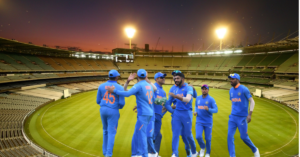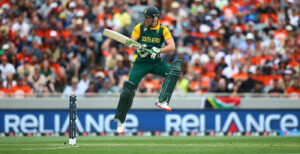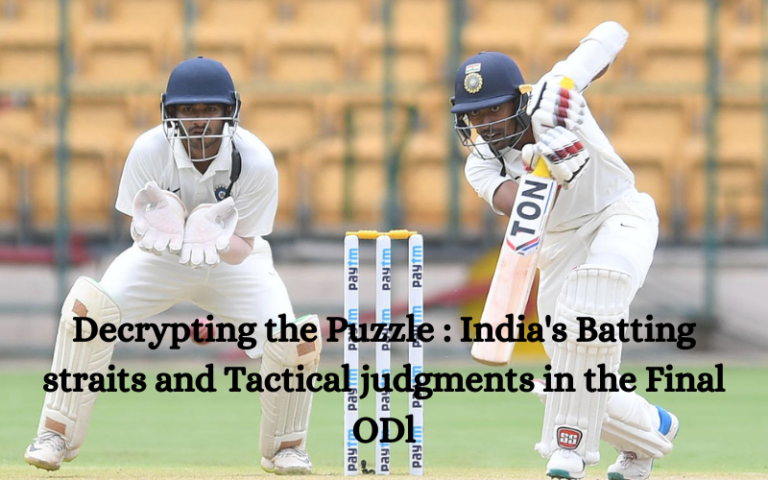Decrypting the Puzzle : India’s Batting straits and Tactical judgments in the Final ODl
The Indian cricket team has lately faced a redoubtable challenge on how to conquer their batting straits in the final ODI match of their series. India’s lack of runs has put them in a precarious position, and they must now identify the reasons behind their recent fur difficulties in order to produce a political resolution that can help them come down with a palm. In this blog post, we will crack the mystification of India’s fur straits and explore political judgments in the final ODI.
1. Overview of India’s poor performance in the ODI series
India’s fur has been the Achilles heel for the team in the ongoing ODI series against Sri Lanka. In the first two ODIs, the Indian top- order failed to make an impact, performing in a middle- order collapse. The third ODI saw a better performance from India, but it was still not over to the mark.
Despite having a strong fur line- up, India has failed to subsidise the openings in the series. The likes of Shikhar Dhawan, Prithvi Shaw, and Suryakumar Yadav have been unfit to give a solid foundation, leading to pressure on the middle order.
India’s inconsistency in fur has been the main reason for the losses in the series. The inability to rotate the strike and put up a good cooperation has resulted in the team falling short of a competitive aggregate.
Going into the final ODI, India needs to address their fur straits and come up with a solid game plan. With the series at stake, the batsmen need to step up and deliver. It’s important for India to find the right balance in their fur line- up and have a strong foundation at the top.
2. Analysis of the fur collapses in the former ODIS
India’s performance in the former ODIs of the series against Australia was below par. The team plodded to put up decent summations on the board, leading to comprehensive defeats in the first two games. The fur defeats were concerning and stressed some crucial issues that demanded to be addressed before the final game.
In the first ODI, India was reduced to 101- 4, before a late flurry of runs by Hardik Pandya and Shikhar Dhawan took them to a respectable score. In the alternate ODI, India lost lattices at regular intervals and were sailed out for just 338 runs, which the Aussies chased down comfortably.
One of the primary issues in India’s fur line- up was the lack of a harmonious nature. Both Mayank Agarwal and Shikhar Dhawan had poor jaunts, leading to early defeats. In addition, the middle- order batsmen, including commander Virat Kohli and KL Rahul, plodded to get going and make hookups.
Another issue was the incapability of the batsmen to rotate the strike and keep the scoreboard ticking. There were long ages of fleck balls, leading to pressure and eventual discharges. The team operation will need to address these issues before the final ODI to put up a strong display and challenge the Aussies.
3. relating the crucial issues in India’s fur line- up
While India’s ODI series against Australia has been largely competitive and amusing, it’s hard to ignore the issues that have agonised India’s four line- up throughout the series. India’s incapability to make hookups and post gruelling summations have put them in a delicate situation.
One crucial issue in India’s fur line- up has been their over-reliance on their top order. In the former matches, the Indian top order comprising of Shikhar Dhawan, Rohit Sharma and Virat Kohli failed to make significant benefactions, putting immense pressure on the middle and lower order.
Another issue that has been apparent is the lack of inflexibility and rigidity in their fur approach. India has plodded to rotate the strike, and their incapability to make hookups has led to a collapse in the middle overs.
The middle- order batsmen have set up it delicately to play against quality spin, and the failure to rotate the strike against them has led to lattices falling at regular intervals. Likewise, the absence of Hardik Pandya and Ravindra Jadeja has made the lower- order fragile, putting a significant burden on the top order.
The team needs to identify and amend these issues before the pivotal final ODI. It’s pivotal for India to have a solid and flexible fur line- up if they’re to challenge a quality Australian side. It’ll be intriguing to see how India approaches the final ODI, and if they can address the crucial issues in their fur.
4. Tactical resolutions to address the batting woes
To address the fur straits in the final ODI, India’s fur line- up needs to borrow some political judgments . The first and foremost resolution should be to play each ball on its merit, avoid taking gratuitous pitfalls, and make hookups.
This won’t only help them to set a decent target but also will put pressure on the opposition. The opening cooperation of Shikhar Dhawan and Rohit Sharma has to be the foundation of the innings. Both need to give a solid launch and should club for at least 15 overs, furnishing a platform for the middle- order.
The middle- order has to be a little more responsible and play with further intent, which will help to undergird the boat in case of early lattices. Also, the lower- order should also mince in and contribute with some pivotal runs.
India has an excellent four line- up and with a little further tolerance and operation, they can deliver better performances. Also, the team operation should also consider shuffling the fur order according to the match situation.
This could bring out the stylishness of their fur line- up and produce further depth. In the final ODI, it’s essential for India to play according to the situation and make their innings patiently. They should be determined and play with further operation to avoid another fur collapse.
5.Importance of mental strength and adaptability in the final ODI
While political judgments and strategy changes are important for a team’s success, internal strength and rigidity are inversely pivotal in the final ODI. India’s four line- up has been facing a lot of review and pressure due to their poor performance in the series.
In similar situations, it becomes important for the players to maintain their internal strength and concentrate on their game plan. Rigidity is also an important factor, as the team needs to be suitable to acclimate to the playing conditions and the opposition’s strategy.
The final ODI is the last chance for India to regain the series and end it on a positive note. This is where the team’s internal durability and rigidity will be tested the most. Players need to be suitable to manage with the pressure and perform under gruelling circumstances.
They need to be suitable to acclimatise to any situation, be it a change in the pitch or a change in the opposition’s tactics. Mental adaptability and rigidity will be pivotal for India’s success in the final ODI.
Conclusion:
India’s fur straits in the ODI series have been a cause of concern for the team operation and suckers likewise. The repeated defeats and lack of thickness in the four line- up have put India under pressure in the series. Still, the final ODI presents an occasion for India to address these issues and end the series on a high.
The key to resolving India’s fur straits lies in relating the root causes of the problem. The team operation must dissect the performance of each individual player and identify their strengths and sins. Based on this analysis, political judgments must be enforced to ensure that the fur line- up is well- rounded and able to
handle different situations.
Also Read : The Ronaldo Show Continues: A Jaw-Dropping Header Leads Al Nassr To Victory
Also Read : How Many Jobs Are Available In Basic Industries


